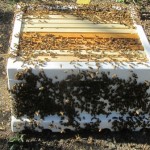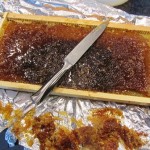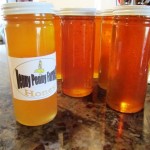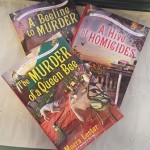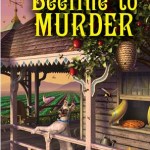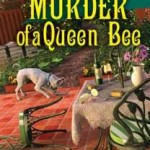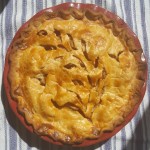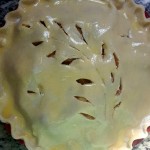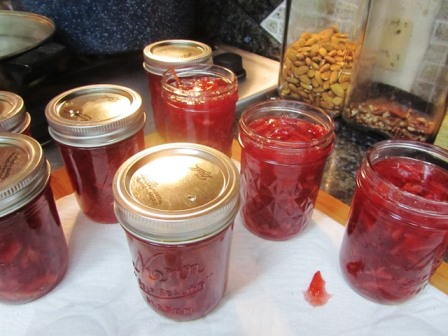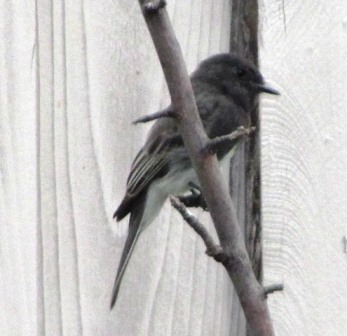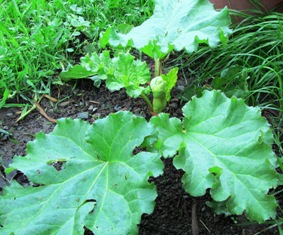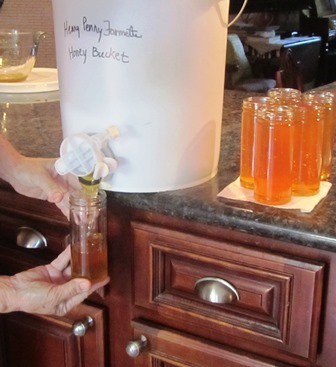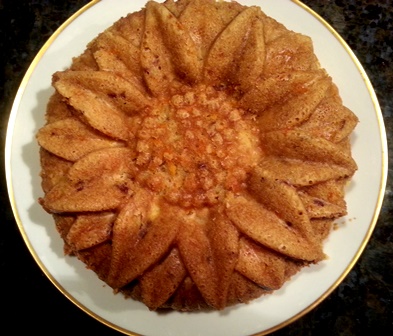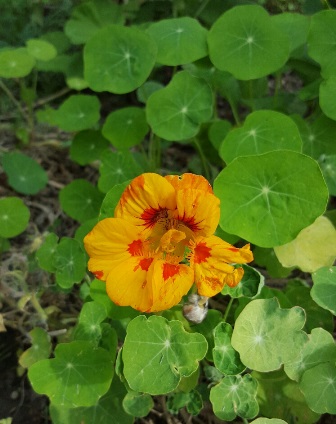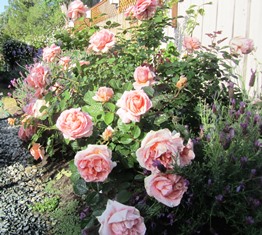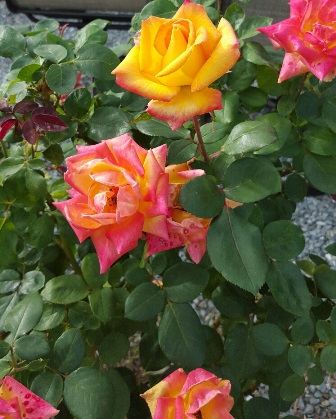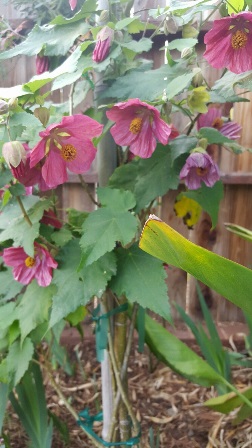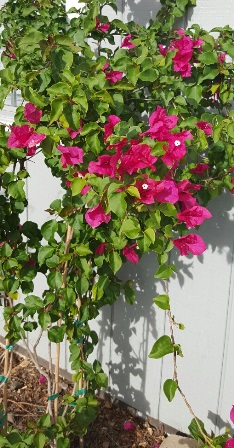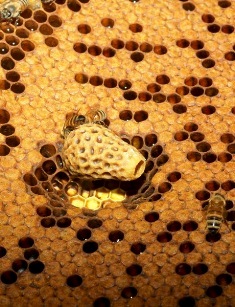Keeping Bees Feeds the Family
The sight of bees collecting pollen makes me happy. Always has. Honeybees are vital to the production of the foods we love such as almonds, apples, citrus, melons, and a large variety of vegetables. My vegetable garden and fruit trees are incredibly productive because of my backyard bees. I guess you could say they feed my family through pollination.
Bees are pollinators. Without them there’s a good chance we’d suffer food scarcity on our planet. Three out of four crops around the globe that are foods that we humans eat are dependent in large part on pollinators. Honeybees also produce honey, nature’s most delicious sweetener, in my opinion.
I keep hives of honeybees on my farmette. It’s not a commercial operation but a backyard hobby that supplies honey for my family and friends as well as pollinating a huge variety of vegetables, fruits, and berries that I grow. Caring for the bees is relatively easy. Harvesting honey, on the other hand, is a bit of work but work I am happy to do.
The first step in harvesting honey is to open the hives. The use of a smoker helps calm the bees. Working quickly is a good idea. We never remove all frames of honey from the hive, but rather leave frames with baby bees and some frames with honey so the bees have food, too.
New frames (some are previously used frames that have the wax structure intact) are inserted to replace the removed frames of honey. A super with 10 frames of honey is carried into my kitchen. Inevitably, I have to capture and release a half dozen live bees that ride in on the frames.
Each frame then gets a hot knife slipped just under the layer of wax. With the wax removed from both sides of the frame, only honey is left. This must be spun out or drained off.
I put four frames of honey at a time into the spinning machine in my kitchen. Beneath the machine’s spigot is freshly washed honey bucket, draped with a new cloth strainer that I’ve taped in place over the top of the bucket. It will catch any pieces of wax or other debris.
When the bucket is full, the strained honey is poured into jars to use, store, or give away as gifts. I put a tight-fitting lid on the bucket and keep the bucket within easy reach on the kitchen countertop.
We eat honey year round. I especially love it in the winter because it reminds me of the honey-flow in spring when the farmette smells like honey and my kitchen is saturated with the scent after pulling some frames from the hive.
Also, the vegetables and fruits that I harvest throughout the growing season are either immediately consumed or preserved through hot-water canning, dehydration, flash freezing. I thank Mother Nature for the blessing of bees that pollinate our foods and give us delicious honey from their hive–up to six gallons for ten frames from a full-depth box!
*NOTE: Learn more about honey bees at: https://www.nationalgeographic.com/animals/invertebrates/h/honeybee/
Also, check out: https://honeybeenet.gsfc.nasa.gov/Honeybees.htm
___________________________________________________________
Enjoy reading about country living? Check out my Henny Penny Farmette series of cozy mysteries that also include lists of farm chores, delicious recipes, farm sayings, and tips for healthy living. Or, take a look at my health, wellness, and spirituality books. All are available online and everywhere books are sold.

More than 150 rituals for sound mind, strong body, and meaningful connections to the people around you
Transplanting a Decades-Old Crape Myrtle Tree
Friends said it was a bad idea. The tree was too large, too old, and too unwieldy to dig up and transport from my daughter’s property to mine. The crape myrtle would not survive, they told me, because its large root would need to be severely cut. Also, without a crane or other lifting device, three of us would be struggling to deal with such a heavy tree.
I won’t say moving the tree was easy. It had been standing for 28 years next to my daughter’s house, but she wanted to make way for new landscaping. When the family decided to part with the tree, they called on a family friend who worked as an arborist. He would do the cutting and digging of the tree.
Crape myrtles (of the genus, lagerstoemia) are available as shrubs and trees and are lovely in bloom with showy paniculate flowers in pink, fuchsia, red, or lavender. They are one of the trees that make little-to-no pollen (great for allergy sufferers). Light pruning during the growing season can produce a second bloom. Much beloved in the deep south, these trees remain stately and beautiful for up to fifty years.
My daughter’s tree arrived at the farmette in mid-October strapped onto our friend’s truck. The roots had been cut away. There were no fine root hairs or stems left–just bare wood. Ditto for the tree canopy–just a few hefty branch stubs. I wondered if our efforts would prove futile.
Hubby and I prepared a large planting hole just off from the patio. We added amendments to the clay soil and drove in stakes to keep the tree stable for a year or more until it had sufficiently developed roots. I added root hormone to the soil and watered deeply the first day and several times that week.
The winter rains came. I watched, waited, and wondered if there would ever be sprouting of any kind on the woody ends where branches had been amputated. Despite a canopy, the tree’s trunk, a beautiful, gray-green wood, afforded a kind of beauty to the austere winter garden. Before spring, I scraped a fingernail on the back of the trunk and discovered the wood was not dried out but as green and moist as a young sapling.
A spell of warm weather and the buzzing of bees in early spring drew my attention upward. Our tree had sprouted a flurry of bronze-green leaves. Pink blooms will likely appear in June or July.
I’m happy now that we went to all the trouble of bringing that tree onto the farmette for transplanting. We’ll have lovely pink blooms over the remaining summers of my life thanks to the crape myrtle tree being so long-lived.
__________________________________________________________________
If you enjoy reading about gardening and farming topics, check out my Henny Penny Farmette series of mysteries: A BEELINE TO MURDER, THE MURDER OF A QUEEN BEE, and A HIVE OF HOMICIDES (Kensington Publishing).
Each book is chocked full of tips for gardening, keeping bees and chickens, and growing heirloom fruits and vegetables. There are also plenty of delicious recipes to try. Find these books on Amazon.com, Barnes & Noble.com, Walmart.com and other online retailers or purchase at traditional bookstores everywhere.–Meera Lester
Pie to Welcome Autumn, Plus a Few Apple Facts
Autumn officially arrives next Friday, September 22, 2017. That means peak apple season has begun and nothing says “fall” like an early-autumn apple pie.
Here’s my easiest apple pie recipe.
COUNTRY APPLE PIE
Ingredients:
6 cups apples, peeled, cored, and thinly sliced
3/4 cup granulated sugar
2 tablespoons butter
1/8 teaspoon salt
1 teaspoon cinnamon
1/2 teaspoon ground nutmeg
2 tablespoons flour
2 unbaked pie crusts (homemade or store-bought)
1 egg, beaten with 2 tablespoons water (to make an egg wash)
Directions:
Preheat oven to 450 degrees Fahrenheit
Combine sugar, flour, salt, cinnamon, and nutmegr in a large bowl and mix well. Stir in the apples. Spoon the apples into a pastry-lined baking dish or pan. Cut the butter into small pieces and distribute over the apples. Place the second rolled-out crust over the pie. Snip off the excess crust and cut a design into the top crust to create a steam vent. Flute crust edges. Use a pastry brush to apply the egg wash over the top crust.
Bake for 10 minutes. Cover crust edges with aluminum foil to keep them from burning. Reduce heat to 350 degrees and bake for 30 to 35 minutes. Crust will be golden brown and juices will be bubbling.
FACTS ABOUT APPLES
1. Apples were known in the ancient world; they’ve been around for 3,000 years.
2. Apples thrive in a temperate climate and are grown worldwide.
3. There are roughly 7,000 varieties of apples worldwide, all members of the rosaceae family.
4. Washington state produces half of all U.S. apples.
5. Science shows that apples are rich in antioxidants and vitamins A and C, are high in fiber, and and aid in lowering cholesterol and high blood pressure. They can help stabilize blood sugar levels.
6. Some of the best-loved apple varieties include: Braeburn, Red Delicious, Granny Smith, Gala, Fuji, Golden Delicious, Honeycrisp, and Rome.
If you want to know which apples are best for baking, eating fresh, making into sauces, or freezing, see, http://bestapples.com/varieties-information/varieties/
_____________________________________________________________
If you enjoy reading about delicious farm recipes, growing heirloom plants, or keeping bees and chickens and you like a mysteries, check out my Henny Penny Farmette series of cozy mysteries from Kensington Publishing in NY. They’re available online and in traditional bookstores everywhere.

Murders at a N. California winery are the catalyst for ex-cop turned farmette owner Abigail Mackenzie to search for a killer
Currently, A HIVE OF HOMICIDES is a featured title in Barnes & Noble’s September promotional BUY 3, GET 1 FREE sale.
WHAT IS THE BUY 3, GET 1 FREE OFFER?
Everyone who buys a Kensington cozy mystery from the B&N in-store display or any Kensington cozy mystery from BarnesandNoble.com between 9/5/17 – 10/5/17 and registers their purchase at http://sites.kensingtonbooks.com/kensingtoncozies/BN/ will:
— Automatically be entered into Kensington’s “Cozy Mystery Bonanza” sweepstakes for a chance to win a $300 value gift basket. One grand prize winner will be selected after the sale has concluded.
— Automatically receive a free Kensington Cozies recipe booklet plus a download code for the novel A STORY TO KILL by Lynn Cahoon after the sale has concluded.
* * *
DON’T FORGET TO ENTER THE FREE DRAWING AT GOODREADS.COM.
Win a signed copy of A Hive of Homicides along with a gorgeous reversible apron and a set of 2 chicken napkin rings. Enter before September 26 for a chance to win.
See, https://www.goodreads.com/book/show/33911114-a-hive-of-homicides?from_search=true
20 Things to Do on a Farm When It’s Raining
Rain . . . unrelenting rain makes working outside near impossible. Since rain is in the forecast for the rest of this week, I’m doing indoor projects here on the Henny Penny Farmette. Why? Because let’s face it: try driving screws into wet fence boards or digging when the earth is like a giant mud ball, or pruning trees when looking upward against a downpour is rather ridiculous. Here are some things to do inside until the weather clears up.
1. Clean the clutter from the kitchen and test some new recipes
2. Read seed catalogs
3. Order beekeeping supplies (to be ready when the weather turns warm and the bees get active)
4. Make a batch of blood orange marmalade (since blood oranges are ripe now)
5. Feed bees, birds, and other wildlife
6. Work on indoor renovation such as finish the installation of base boards and crown moldings
7. Sew curtains; make a quilt, or start an embroidery or knitting project
8. Start the spring cleaning in one or more indoor rooms
9. Plan the spring vegetable garden on paper with a drawing
10. Clean out closets and recycle unused items from cupboards and drawers
11.Make herbal teas (for example: dried leaves of herbs such as mint, dried lemon or orange peel, spices, rose hips, and dried berries)
12. Catch up on your reading for pleasure or books and periodicals about farm and homesteading topics
13. Bring your beekeeping or gardening journal up to date
14. Order supplies–antibiotics for the chickens or medicines for your bees and other domestic stock
15. Bottle honey from the bucket and affix labels
16. Make a dazzling dessert
17. Mend clothing
18. Start working on the taxes for the upcoming season
19. Play your fiddle, piano, horn, or drum
20. Start heirloom seed in flats or get some sprouts growing in a jar
* * *
If you enjoy reading about farming topics, check out my cozy mystery series from Kensington: A Beeline to Murder, The Murder of a Queen Bee, and A Hive of Homicides. Delicious recipes, farm lore, and tips for keeping chickens and bees add to the charm of these delightful mysteries.

- COMING September 2017
- These books are available through online retailers and traditional bookstores everywhere.
See, http://tinyurl.com/hxy3s8q
A Beeline to Murder is the debut novel that launched the Henny Penny Farmette series of mysteries.
See, http://tinyurl.com/h4kou4g
The second cozy mystery in the Henny Penny Farmette series is garnering great reviews from readers and industry publications.
Seasonal Blooms for Floral Arrangements
Autumn in Northern California is one of my favorite times of the year. By November, many of the summer blooms in our flower beds have faded. Seeds have been collected for next year’s blooms. Now’s the time to put in bulbs and tubers for spring, but that doesn’t mean we have no blooms for a Thanksgiving floral arrangement.
The clocks have been turned back and the rainy season has arrived, but don’t tell that to the roses.
Red-gold roses, pyracantha berries, rustic seed pods, orange- and rust-colored zinnias, asters, willowleaf cotoneaster, and dahlias are some of the garden plants that combine beautifully in a fall floral arrangement. To the harvest table, I also like to add some seasonal fruits like pomegranates and persimmons.
Thanks to the recent rain, the bougainvillea blazes in shades of fuchsia, orange, red, and purple. Zinnia’s near the farmette’s bee house are still holding color and hanging on until cold weather arrives.
And while pyracantha (fire thorn) berries add splashes of bright orange to a dark corner of the garden where bamboo towers to ten feet, the Chinese lantern plant holds aloft dozens of small pink blooms like little lanterns.
With Thanksgiving three weeks away, I’m feeling confident that our table arrangement will include some of the season’s festive berries, seed pods, and blooming flowers collected from around the farmette.
In the meantime, I’ll notice the splashes of color to be discovered here and there and consider how to use them in a holiday bouquet.
* * *
NEWLY RELEASED–The Murder of a Queen Bee (Kensington Publishing, NY–Sept. 2016).
Discover delicious farm-to-table recipes, farming tips, and wisdom as well as sort out a charming whodunnit. Also, enjoy gardening tips and farm sayings. Dig for clues while learning about bees and chickens. To learn more, click on the link under the picture.
See, http://tinyurl.com/h4kou4g
See, http://tinyurl.com/hxy3s8q
This debut novel launched the Henny Penny Farmette series of mysteries and sold out its first press run. It’s now available in mass market paperback and other formats.
Predators on the Prowl
Are they venturing out of the nearby dry hills and canyons for water? Or, in search of a fresh chicken dinner? Whatever the reason for their forays into our neighborhood, the foxes are back.
- This fox pair dug a den near a compost pile on the property adjoining our Henny Penny Farmette last year . . . now they’re back
My neighbor, who also has a farmette with chickens, bees, and fruit trees, alerted me first that the foxes had returned because they got one of his chickens.
With that worrisome news, I’ve decided against allowing my chickens to free-range forage around our property. Instead, I’m keeping them safe in the chicken run that also has poultry wire across the top to protect against high-flying predators like hawks or cunning little climbers like foxes.
Although we live fairly close (a mile or so) away from designated agricultural land, ours is still a neighborhood of families with pets. Some of us keep chickens and bees and even goats and horses and burros. I sometimes hear braying or neighing while having coffee in my garden on a bright, crisp autumn morning.
A flock of wild turkeys roams through our property this time of year, too. We don’t mind the turkeys but foxes, large raccoons, coyotes, and wolves can attack small dogs and cats. For that reason, we all stay alert and share news with our neighbors of predators prowling about.
* * *
If you enjoy reading about farmette topics (including gardening, beekeeping, and delicious recipes), check out my cozy mysteries A BEELINE TO MURDER and also THE MURDER OF A QUEEN BEE in the Henny Penny Farmette series (from Kensington Publishing).
Enter the Goodreads Giveaway–September 29 to October 6–for a chance to win a signed copy of a first-edition hardcover of The Murder of a Queen Bee. Three lucky winners will be chosen.
These novels are chocked full of recipes, farming tips, and sayings as well as a charming cozy mystery.
The books are available through online retailers such as Amazon, Barnes & Noble, Kobo Books, and Walmart as well as from traditional bookstores everywhere.
See, http://tinyurl.com/hxy3s8q
This debut novel launched the Henny Penny Farmette series of mysteries and sold out its first press run. It’s now available in mass market paperback and other formats.
See, http://tinyurl.com/h4kou4g
NEWLY RELEASED! This, the second cozy mystery in the Henny Penny Farmette series, is garnering great reviews from readers and industry publications.
Happy birthday/release day to THE MURDER OF A QUEEN BEE
Today’s blog will be a short one–I’m tracking down the foxes that showed up on my front porch after snagging a chicken from my neighbor’s hen house. The foxes stood on my front porch late last night. My hubby saw them and thought they were cats. He checked on our chickens to make sure they were safe and called me.
I am house-sitting and pet-sitting for a relative who lives a mile away. This means I am running back and forth between the two properties, while trying to blog, do farming chores, and clean.
But today is special because it is the official release day for THE MURDER OF A QUEEN BEE, the second cozy mystery in my Henny Penny Farmette series. So I’m taking an extra hour or two here and there to blog and post publicity.
I’m thrilled that already the book is garnering praise from industry publications like Kirkus Reviews, Publisher’s Weekly, and Booklist. Additionally, it is creating buzz in the cozy mystery and new fiction blogosphere.
Goodreads has a giveaway for three autographed, hardbound copies of THE MURDER OF A QUEEN BEE. The giveaway drawing runs from midnight September 29 through midnight August 6. See more at https://www.goodreads.com/book/show/28439447-the-murder-of-a-queen-bee
Happy birthday/release day to my second novel, and good luck everyone entering the drawing. I hope you like ex-cop turned farmette owner Abigail Mackenzie’s newest adventure involving the murder of her herbalist friend Fiona and Fiona’s links to a New Age cult.
Birds that Eat Bees
Lately, I’ve noticed a scrub jay visiting my apiary. The bird most often lands on the bubbling water fountain near the front of the hives, but it visits other fountains in the yard as well. A favorite spot is the pink birdbath near the Pyracantha bush and stand of bamboo.
The bird eats its fill of bees corpses on the gravel path in front of the hives. Occasionally, I’ve seen it snatch a bee out of the air–something I don’t like. After washing down its meal with water, off it goes.

Western scrub jays are omnivores and eat nuts, seeds, berries, small rodents, reptiles, other birds’ eggs, and insects.
While bees aren’t the primary dietary food of scrub jays, the birds will eat bees that are dead or alive.
Purple Martins, the largest type of swallow in the United States, eats bees in flight, too, provided the insects zoom high enough to enter the Purple Martin’s flight zone.
Other birds that eat bees include flycatchers, tufted titmice, swifts, and shrikes (because of their feeding habits, some shrikes are known as “butcher birds” because they impale prey on thorns). European beekeepers must deal with Bradfield’s swift and the Green Bee-eater; both eat bees that are flying about to forage or mate.
The majority of bee-eating birds belong to a relatively small group of twenty-four species that feed mainly on honeybees but also devour bumblebees, dragonflies, wasps, ants, butterflies, hornets, beetles, and moths as part of their diets.
But back to the scrub jay–these birds serve a custodial function for my apiary. With dead bees attracting hornets and yellow jackets, the scrub jay is doing me a favor by cleaning up around the hive entrances. This is especially true in the autumn, when the worker bees preparing their hive for winter, push out the drones (male honeybees) to die.
* * *
If you enjoy reading about farmette topics (including gardening, beekeeping, and delicious recipes), check out my cozy mysteries A BEELINE TO MURDER and also THE MURDER OF A QUEEN BEE in the Henny Penny Farmette series (from Kensington Publishing).
These novels are available through online retailers such as Amazon, Barnes & Noble, Kobo Books, and Walmart as well as from traditional bookstores everywhere.
See, http://tinyurl.com/hxy3s8q
Now available in mass market paperback, this debut novel launched the Henny Penny Farmette series of mysteries and sold out its first press run.
See, http://tinyurl.com/h4kou4g
The second cozy mystery in the Henny Penny Farmette series, available Sept. 27, 2016, is now available on Net Galley (netgalley.com) for professionals and readers who write reviews.
Giant Sunflowers Brighten a Garden, Cornfield, or Wall
Ralph Waldo Emerson once observed, “The earth laughs in flowers.” Among the many flowers I plant around the Henny Penny Farmette each year, sunflowers are my favorites.
What’s not to love about these gorgeous beauties that inspired master artists like Van Gogh, Monet, and Gauguin as well as farmers like my grandmother who put them in fruit jars and crockery to brighten the rooms of her Missouri farmhouse?
I like to grow smaller ones at the back of a flower bed and the giant ones against walls or at the back of my patch of summer corn.

These sunflowers stand about 12 feet tall and produce several heads. Heritage varieties produce several heads.
Giant sunflowers need space to grow to full size since they will grow well over six feet. In my garden, they tower over the corn. Bees love them for their pollen. Kids love them when the foliage of the plants create a secret fort or a fairy circle. Humans, birds, and squirrels love them for their seeds.
For best results, plant giant sunflowers at the back of a garden. They need good soil and full sun. Plant when the danger of frost has past. A rule of thumb to follow is to plant them about one inch deep and six inches apart. While the seeds are germinating, keep the soil moist.
Later on, when the plants stand about three inches tall, you can thin them. Leave about one foot between each plant. This enables a strong root system for form. The stalks will become sturdy and measure about three to four inches in circumference when fully grown.
First come the gorgeous petals in green to yellow and then bright yellow. As the bees pollinate the florets and they drop, the seeds will mature. Seeds are either gray or brown in color.
I always cut the heads when the seeds are plump, firm, and begin to drop. I let the heads dry well in the sun for days before I remove the seeds. Fully dry seeds can be stored in containers for human consumption or to be fed to the squirrels and birds. Don’t forget to save some for planting in next year’s garden.
* * *
If you enjoy reading about farmette topics (including gardening, beekeeping, and delicious recipes), check out my cozy mysteries A BEELINE TO MURDER and also THE MURDER OF A QUEEN BEE in the Henny Penny Farmette series (from Kensington Publishing).
These novels are available through online retailers such as Amazon, Barnes & Noble, Kobo Books, and Walmart as well as from traditional bookstores everywhere.
See, http://tinyurl.com/hxy3s8q
Now available in mass market paperback, this debut novel launched the Henny Penny Farmette series of mysteries and sold out its first press run.
See, http://tinyurl.com/h4kou4g
The second cozy mystery in the Henny Penny Farmette series, available Sept. 27, 2016, is now available on Net Galley (netgalley.com) for professionals and readers who write reviews.
Why Use a Screened Bottom Board in the Hive?
When beekeepers see signs that the population of Varroa destructor mites are increasing in the hive, they will take action to reduce the mite population. One way they can track mite levels is by using a screened bottom board.
A close monitoring of a screened bottom board can give a beekeeper a good idea of whether or not the mite population is increasing or decreasing in the hive.
Mites fall through the screen to the ground. A screened bottom board stretches across a platform that the hive box sits on.
When the mites in a hive fall on solid bottoms in a hive box, they can ride back up into the interior of the hive on other bees. A great article for building your own screened bottom board can be found at http://www.michiganbees.org/wp-content/uploads/2012/03/Screened-Bottom-Board_20110324.pdf
The use of a screened bottom board prevents bees returning upwards in the hive. One sign of mites at work in a hive are wings missing from newly emerged baby bees. There are other signs as well.
For lots of interesting bee “stuff” as well as farming tips and delicious recipes, check out my newest novel, A BEELINE TO MURDER.
Now available online and from brick-and-mortar bookstores everywhere. See, http://tinyurl.com/p8d6owd
 Facebook
Facebook Goodreads
Goodreads LinkedIn
LinkedIn Meera Lester
Meera Lester Twitter
Twitter




